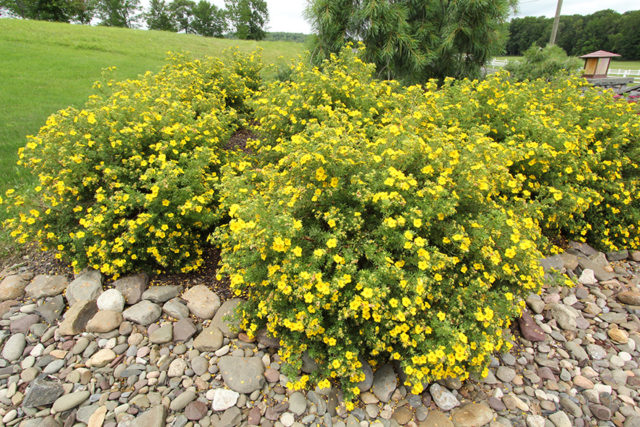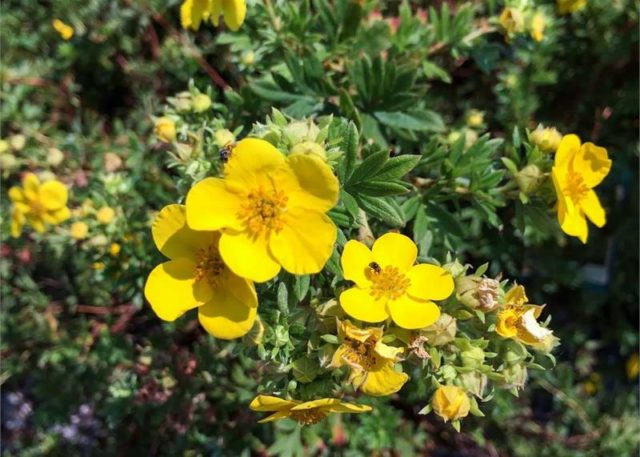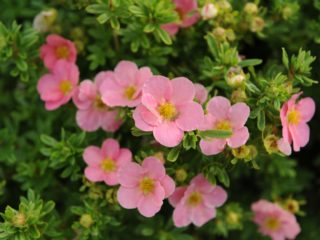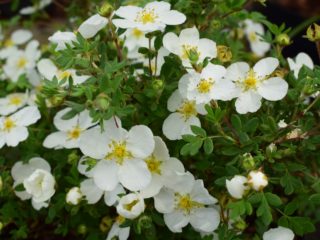Content
Goldfinger's cinquefoil is an ornamental shrub that is often used as a hedge. A distinctive feature of this variety is the rather large buds of rich yellow color, attracting many gardeners. The crop grows slowly and does not require much effort in the cultivation and care process. Goldfinger is a great option for mass landing.
Description Potentilla Goldfinger
The Goldfinger Shrub Potentilla is an excellent option if you want to decorate a plot of land, attract insects, or arrange a hedge.
Among the characteristics, the following points can be noted:
- the bushes are low, grow rather slowly, the maximum height is 1.5 m;
- the crown is wide enough, the leaves have a decorative appearance, a distinctive feature is the large yellow buds that appear during the flowering period;
- the roots are poorly developed, as a result of which the planting should not be deep.
The flowering period begins in late spring and lasts until early autumn, as a result of which the culture can rightfully be considered a decoration.
Cinquefoil Goldfinger in landscape design
Due to its attractive and at the same time decorative appearance, shrub cinquefoil (potentilla fruticosa Goldfinger) has found wide application in landscape design. As practice shows, the culture is often used in the plots as a hedge. If necessary, you can arrange group plantings, but at the same time, single plants also do not lose their attractiveness, which is facilitated by abundant and bright flowering.
Planting and caring for Goldfinger Potentilla
As practice shows, planting and caring for Goldfinger shrub cinquefoil does not take much time and effort. The culture is unpretentious in care, practically not susceptible to the appearance of diseases and pests. All that is required in this case is to choose the right site for planting, plant the plants, and then fertilize and water several times throughout the season.
Landing site preparation
You can plant a culture in any convenient place, but you should understand that each option has its own characteristics:
- if you plant a plant in the shade, then it will experience a deficiency of sunlight, which will significantly slow down growth;
- if you choose a sunny area, then this will have a great effect on growth, but it should be understood that Potentilla does not tolerate drought.
Before planting a crop, it is recommended to remove weeds on the selected plot of land, dig up the soil, and apply fertilizer if necessary.
Landing rules
Planting Potentilla varieties Goldfinger is recommended to be engaged in early spring, while it is worth adhering to certain rules:
- The first step is to dig a hole, the depth of which is about 50-60 cm.
- The pit is covered by about half of crushed stone or broken brick.
- The culture is carefully planted, sprinkling the root system with soil.
- If necessary, you can add mineral fertilizers and humus.
At first, young bushes should be regularly watered using warm, settled water for this purpose.
Watering and feeding
In the process of watering, you should not allow stagnation of moisture, as this will negatively affect the Goldfinger Potentilla - the culture may die. It is for this reason that irrigation should only be done during drought. During the season, watering is carried out 3 to 5 times, using 10 liters of water for each bush.
An excellent option for feeding are mineral and organic fertilizers. The first feeding, as a rule, falls on the moment of planting Potentilla, the second - a month later. Re-fertilization can be done during the flowering period.
Pruning
In the process of growing, it is important to take into account not only the description of the Goldfinger Shrub Potentilla, but also the recommendations for care. Thus, the crop needs pruning during growth, which is recommended in winter, after the threat of severe frosts has passed. Some gardeners carry out these procedures in early April or September, when it becomes necessary to make the appearance of the shrub even more decorative. Shoots should be cut by about 10 cm, but not more.
Preparing for winter
Despite the fact that the cinquefoil shrub variety Goldfinger is unpretentious in cultivation and care, do not forget about the minimum agrotechnical standards. Thus, in practice, shrub cinquefoil is resistant to temperature fluctuations, as a result of which shelters are not required for the winter. In this case, it is not required to dig up the culture and transfer it to the greenhouse, use special shelters and create conditions for wintering. Goldfinger cinquefoil is left outdoors in winter without any changes.
Reproduction of Potentilla shrub Goldfinger
If necessary, the Goldfinger variety cinquefoil can be propagated at home and there are several ways for this:
- dividing a bush - work is carried out in spring or autumn and only in warm regions. The bush is divided into two parts, after which each part is rooted;
- cuttings - this option has a large number of subtleties. In this way, it is worth cutting off the woody shoot, on which there are at least 3-4 leaves, after which it is planted in the ground;
- seeds - as practice shows, the process of germination of planting material is standard; separate containers or boxes are used for planting. Seedlings are planted in open ground in April;
- layering - in this case, you will need to make small cuts on young shoots, bend them to the soil, sprinkle with a small amount of earth. The roots will appear in about 1.5 weeks.
Each gardener can choose exactly the breeding method that seems to be the most convenient and simple.
Diseases and pests
As practice and reviews of many experienced gardeners show, the Goldfinger shrub cinquefoil is practically not susceptible to diseases and the appearance of pests during the cultivation process. In the event that the summer period is sufficiently humid and cold, then problems cannot be avoided - a fungus may appear on the bushes. In such situations, it is recommended to carry out the treatment using fungicides. Among pests, scoops are popular, which can be eliminated with the help of insecticides.
Conclusion
Goldfinger's cinquefoil is capable of decorating any area and contributes to this attractive appearance of the culture. Many gardeners prefer this variety not only for beautiful and bright buds, but also for the fact that the culture is unpretentious in care and cultivation, as a result of which a lot of time and effort is not required.










